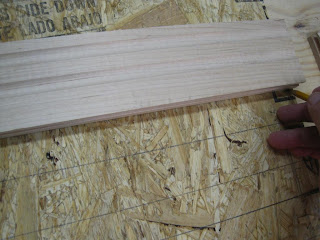As it
happens, the work is not perfectly flat! Don’t know if it is a thermal
coefficient of expansion “fight” between the Maple and the Advantech or what.
Anyway,
today, I completed the band board prep. Details below!
 |
|
I decided
on the stop board method with finger check, loosening the clamp if necessary to
bring tops of band board into alignment with counter top. Then a tap with the
rawhide mallet and a trip to the drill press.
|
 |
|
End board
being fitted . . .
|
 |
|
. . . and marked for miter saw cut . . .
|
 |
|
. . .
with the first cut just a smidgen long (“leave the line”).
|
 |
|
Drilling
side holes using dowling jig.
(Important
tip: If you have screws in the countertop, don’t try to drill through them! It
really does a number on the drill bit!)
|
 |
|
Once
again, using rawhide mallet so as to not mar the wood.
|
 |
|
Once the
side band board is cut, the process of fitting the miter corners begins. The
key is patience – you can always cut more off but I haven’t found a supplier
for
“grow-some-board”
When you
get really close, with the power miter box, you can swing the blade down (not
running), bring the work right up to the side of the blade, hold it there while
you make a cut. David and I call this “kissing the wood” – takes a very small
amount of wood off. This whole process
may take 8-12 trips to the power miter box per corner, but its worth it when
you get that perfect fit!
|
 |
|
Ready to
glue up side pieces! Now that all four corners have perfect fits, time to glue
the side pieces. A cotton swab is perfect to wet the holes. The flat wood is
again wet with the acid brush.
|
 |
|
Here’s
the piece with the two side pieces glued and clamped. The dark areas are just damp with water used to remove excess glue.
Since the grain on the
side pieces runs with the grain on the counter top, I can have it attached when
I do my final passes with the belt sander.
I’ll
clamp the belt sander into a woodworking vice to create a table belt sander and
use that to dress the end pieces down to final fit.
|
Next:
Gluing end pieces and final finish sanding with orbital sander.




























